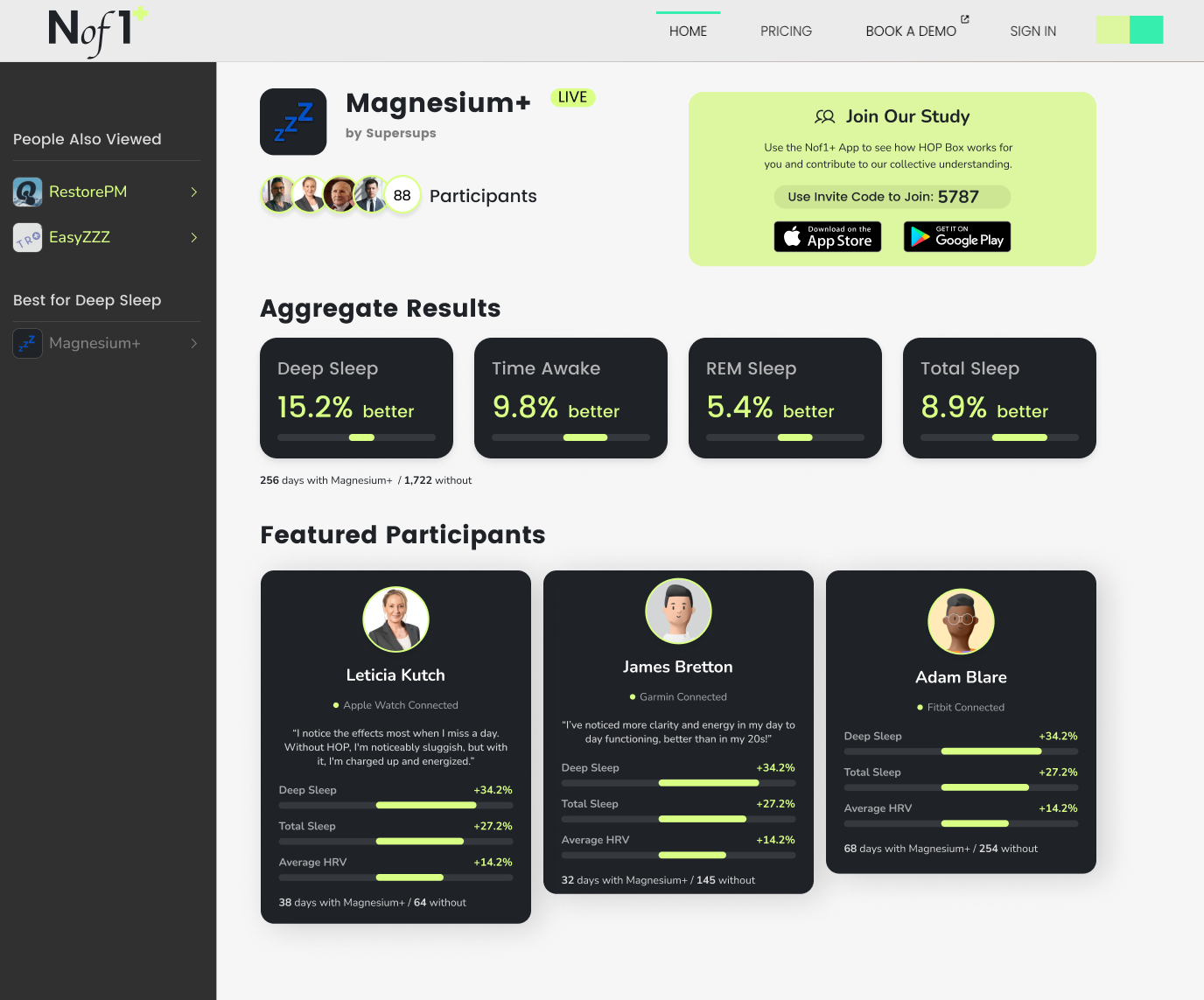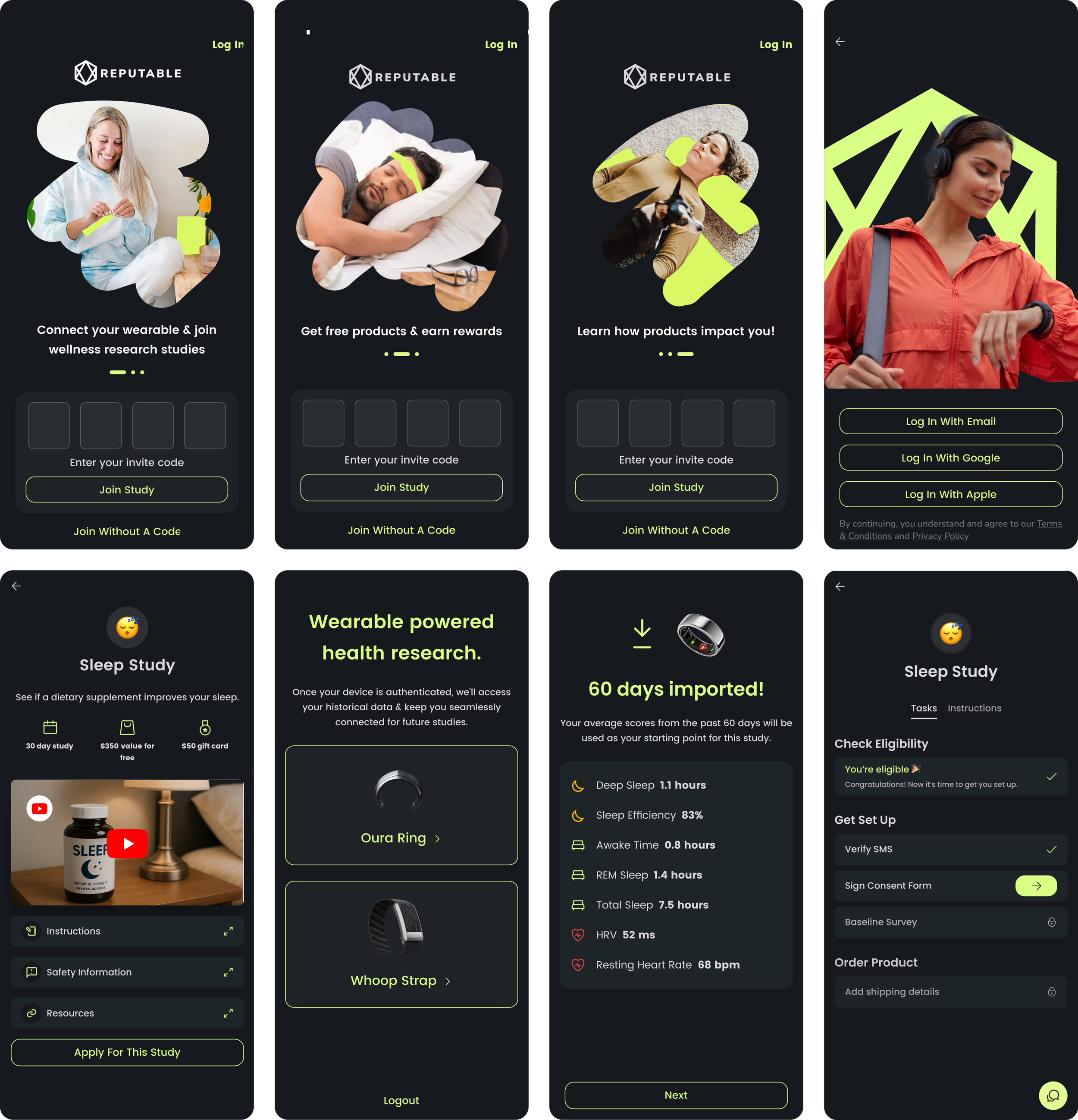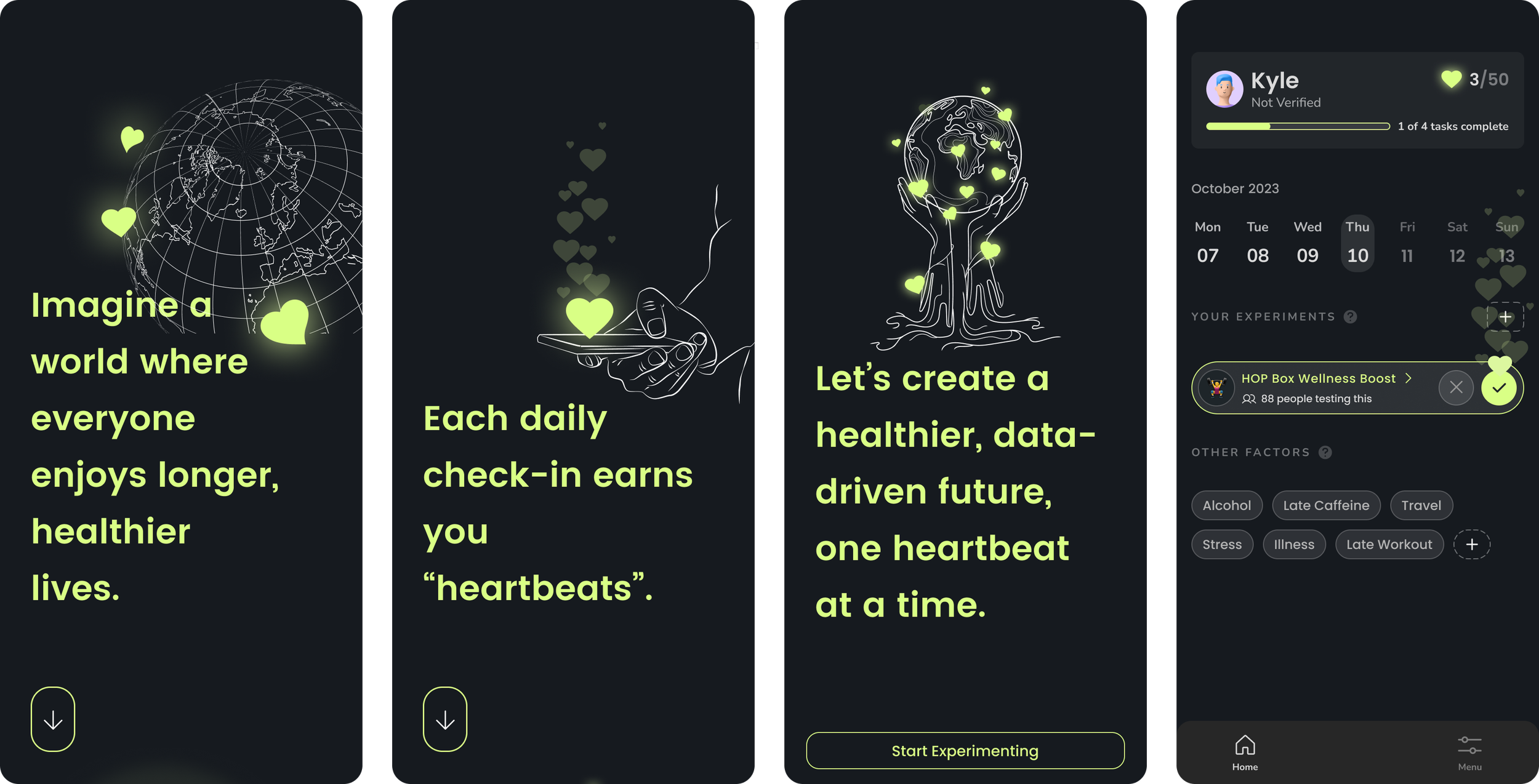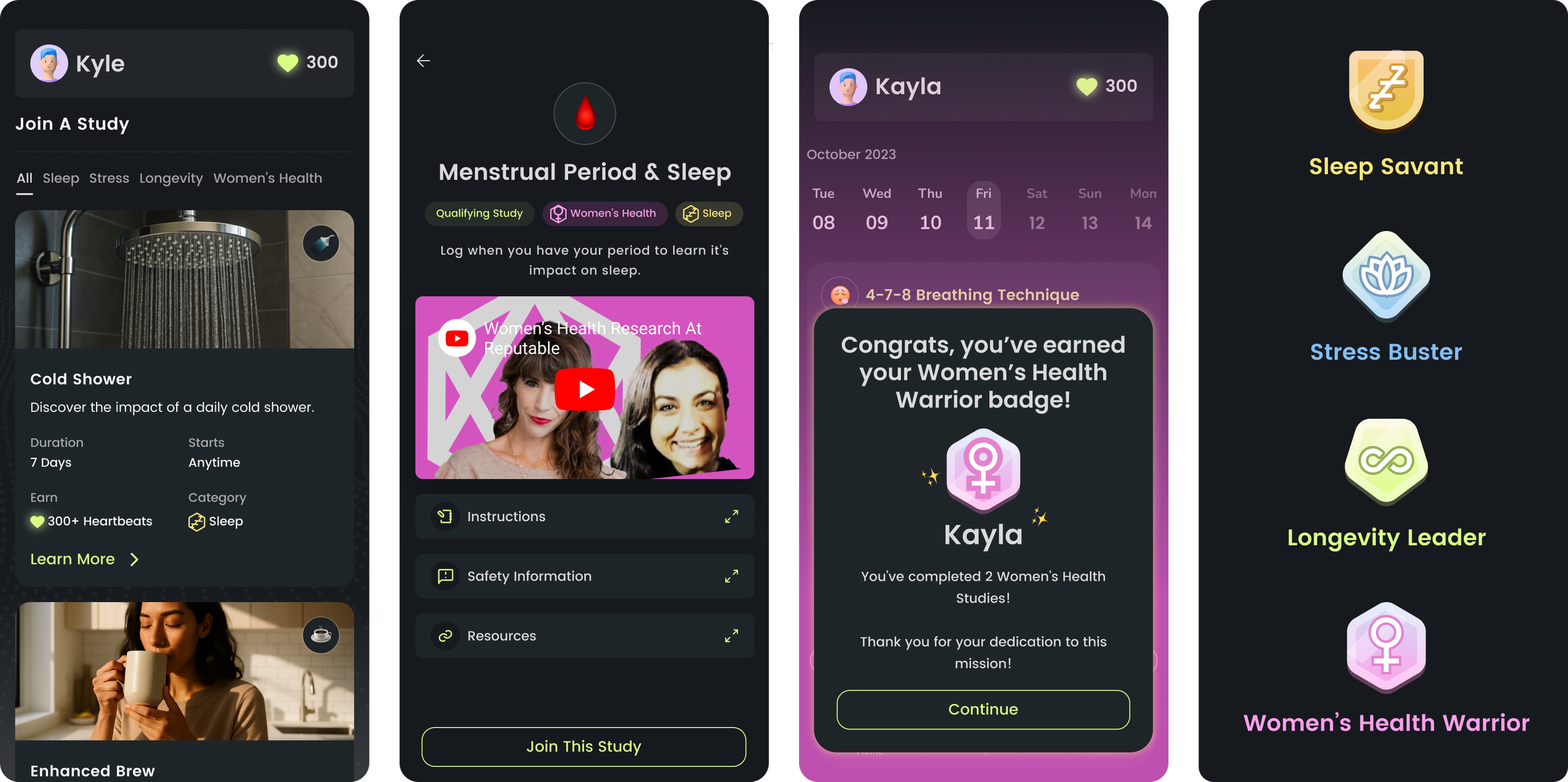Finding Product Market Fit at Reputable Health
This is a look back at 18 months of product design, experimentation, and growth as the first in-house designer at Reputable Health.
Overview
In 2023, I was hired as the Founding Designer at Reputable Health and began playing a pivotal role in the evolution of their health intervention tracking app, Nof1+. Through careful market exploration and iterative development, I rebranded the app and evolved into a scalable Contract Research Organization (CRO) platform. This case study details our search for product-market fit, documenting our path from a consumer-focused app to a B2B research platform.
The Initial Vision
Nof1+ started as a personal health intervention tracking tool, enabling users to test and measure the impact of various health interventions on their wearable device metrics.
We all are familiar with the experience of trying out various supplements, exercise routines, or biohacking devices and being unsure if they are truly making a difference. This can be frustrating, especially if you’re dealing with recurring health issues or poor sleep and you feel like you’re just throwing money away at interventions that may or may not be making an ipact.
The idea behind Nof1+ was to take the guesswork out of health optimization and help people track usage of health interventions and measure their outcomes, syncing with 20+ of the leading wearable devices like Apple Watch, Oura Ring, Fitbit, and Whoop Strap.
Enhancing the Consumer Experience & Onboarding
My first initiative focused on improving the core user experience, onboarding flow, and overall elevating the UI.
Before starting the redesign, the onboarding process was disjointed and contained elements that were not supportive of conveying the utility of the product. After completing onboarding users would churn, unable to understand the value proposition of the app and unsure of how to use it.
I started by auditing the UX, brand documentation, personas and then leading a workshop with the team to align on a set of design opportunities before undertaking the redesign.
I created a new set of user flows, interaction designs, and visual language that addressed our opportunity areas and pain points and created a path forward that the team was excited by.
I prototyped the app in Figma and ran 10 live interviews with Oura Ring users unfamiliar with our product. These sessions revealed key mental models that shaped our onboarding flow and copy. After integrating those insights, I partnered with engineering to build a component library and translate the design into a React Native app for iOS and Android.
Exploring B2B Solutions: Supercharged Testimonials
As we were exploring paths to profitability one idea that got the team excited was to become the “Glassdoor” for wellness products, a public platform where people could browse live study results for products they were considering purchasing. For the same purpose as reviews and testimonials, but supercharged with wearable device data.
I created some conceptual designs for us to use as stimuli for product research.
We envisioned a platform where anyone could transparently see live study results for a large library of wellness products in addition to subjective user testimonials.
Could we leverage QR codes to add these results directly to product labels?
I conducted one on one interviews with 7 wellness product founders about this concept and learned that displaying live study results publicly wasn’t something they would feel comfortable with. We realized that while this vision is compelling for brands and consumers, until this level of transparency became the expectation of consumers we would have a difficult time convincing brands to be some of the first on this frontier.
Pivot to Real World Evidence Studies
Through our conversations with these founders we discovered a promising opportunity in the Real World Evidence (RWE) space. Some pain points were identified with the existing landscape of CRO’s (Contract Research Organizations).
High cost of running studies: $100K+ price tags put quality research out of reach for many wellness brands
Imprecise measures: Few CRO’s were focusing on the power of wearable device data and were instead using subjective surveys.
Long study timelines & lack of transparency: Studies often take at least a few months and some go as long as a year and clients get very little visibility into the data & findings along the way.
Building The Reputable App & Client Dashboard
Since our platform was already sufficient for running basic studies, all that was required to experiment with this new business avenue was a new landing page and sales materials. Once we started making sales to our early clients the product and design team ventured to streamline our app to focus exclusively on study participation:
I conducted over 40 hours of live usability tests and interviews with wearable device users who were interested in participating in wellness product research.
We rebranded from Nof1+ to Reputable to support this new direction
I redesigned the onboarding and core app experience to focus on seamless participation in research studies
I designed a web dashboard so that our clients could have a live window into how their product was performing in the study - a new level of visibility that was highly desirable to brands.
I collaborated with engineering to launch the updated app and client dashboard.
The participant facing mobile app rebranded and optimized for study participation.
The client-facing web dashboard showing participant details and compliance
Live study results for placebo controlled trial: an unheard of level of visibility for wellness brands.
Boosting Compliance With Behavioral Design & Gamification
To improve study participation and daily compliance, we applied principles from behavioral design and gamification, using the Octalysis Framework as a strategic guide. Octalysis outlines eight core motivational drives—ranging from purpose and progress to ownership and unpredictability—that influence human behavior. By aligning our product experience with these intrinsic and extrinsic motivators, we transformed routine actions into meaningful, self-reinforcing habits. The following examples illustrate how we used visual storytelling, reward systems, and user choice to create a more engaging and mission-aligned experience.
To foster daily engagement, we introduced a points system where participants earn "Heartbeats" for logging their health actions. Thematic naming anchored the currency in Core Drive 1: Epic Meaning & Calling, while visualized progress and daily streaks leveraged Core Drive 2: Development & Accomplishment. The accumulation of Heartbeats (redeemable for cash equivalents) activated Core Drive 4: Ownership & Possession, encouraging consistent behavior over time without relying on fear-based tactics.
We designed study categories and collectible badges to promote user agency and mission alignment. Letting users choose topics meaningful to them tapped into Core Drive 3: Empowerment of Creativity & Feedback, while limited-edition badges for category completion drove motivation through Core Drive 6: Scarcity & Impatience and Core Drive 2: Accomplishment. The collection mechanic (badge gallery) offered visible markers of purpose-driven progress, reinforcing Core Drive 4 and keeping momentum high across studies.
Outcomes
Client Dashboard Demo Impacted Sales Growth
Sales growth in Q1 2025 significantly outpaced the previous year, with the sales pipeline expanding from $260,000 in Q4 2024 to $1.55 million—a nearly 500% increase. While the sales and marketing team led this effort, they cited the redesigned client dashboard demo as a key unlock in their process. It consistently delivered an “aha moment” for prospective clients, helping them clearly understand the value of our platform.
Participant App Drove Above-Average Compliance
Studies conducted using the updated participant app achieved compliance rates of 80–90%, significantly outperforming the industry average of 65–70%, as reported by the 2022 Tufts Center for the Study of Drug Development. This elevated performance not only led to higher data quality and reliability for researchers, but also increased client retention and repeat study interest, validating the impact of our behavioral design improvements.
Other signs of success were an average NPS score of 9/10 for study participants across 4 studies, and 80% of participants stating their interest in participating in subsequent studies with Reputable; demonstrating brand loyalty.
What I Learned
Research doesn’t have to be extensive to be valuable.
Working within startup constraints, I conducted monthly tests with just 5–10 users—without expensive tools like UserZoom. Even with this scrappy approach, the insights I gained into users’ mental models, comprehension of onboarding, and expectations for a product like ours were game-changing. It proved how much impact small, focused research can have on delivering a successful experience.
Don’t get too attached to your work.
While this post highlights three major pivots, there were many more behind the scenes—directions we explored through concept design and user feedback that ultimately didn’t pan out. Over time, I became more comfortable letting go of ideas and listening to what the signals (sales, research, operations) were really telling us.
Watching a product find its “home” is incredibly rewarding.
After so much iteration, doubt, and learning, there’s nothing quite like seeing your product finally click—with users, clients, and internal teams. Seeing it meet a real need and start generating pull (instead of push) validated all the quiet, behind-the-scenes work it took to get there.








